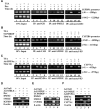Molecular characterization of SMILE as a novel corepressor of nuclear receptors
- PMID: 19429690
- PMCID: PMC2709580
- DOI: 10.1093/nar/gkp333
Molecular characterization of SMILE as a novel corepressor of nuclear receptors
Abstract
SMILE (small heterodimer partner interacting leucine zipper protein) has been identified as a coregulator in ER signaling. In this study, we have examined the effects of SMILE on other NRs (nuclear receptors). SMILE inhibits GR, CAR and HNF4 alpha-mediated transactivation. Knockdown of SMILE gene expression increases the transactivation of the NRs. SMILE interacts with GR, CAR and HNF4 alpha in vitro and in vivo. SMILE and these NRs colocalize in the nucleus. SMILE binds to the ligand-binding domain or AF2 domain of the NRs. Competitions between SMILE and the coactivators GRIP1 or PGC-1 alpha have been demonstrated in vitro and in vivo. Furthermore, an intrinsic repressive activity of SMILE is observed in Gal4-fusion system, and the intrinsic repressive domain is mapped to the C-terminus of SMILE, spanning residues 203-354. Moreover, SMILE interacts with specific HDACs (histone deacetylases) and SMILE-mediated repression is released by HDAC inhibitor trichostatin A, in a NR-specific manner. Finally, ChIP (chromatin immunoprecipitation) assays reveal that SMILE associates with the NRs on the target gene promoters. Adenoviral overexpression of SMILE represses GR-, CAR- and HNF4 alpha-mediated target gene expression. Overall, these results suggest that SMILE functions as a novel corepressor of NRs via competition with coactivators and the recruitment of HDACs.
Figures










Similar articles
-
Curcumin differentially regulates endoplasmic reticulum stress through transcriptional corepressor SMILE (small heterodimer partner-interacting leucine zipper protein)-mediated inhibition of CREBH (cAMP responsive element-binding protein H).J Biol Chem. 2011 Dec 9;286(49):41972-41984. doi: 10.1074/jbc.M111.274514. Epub 2011 Oct 12. J Biol Chem. 2011. PMID: 21994947 Free PMC article.
-
Transcriptional corepressor SMILE recruits SIRT1 to inhibit nuclear receptor estrogen receptor-related receptor gamma transactivation.J Biol Chem. 2009 Oct 16;284(42):28762-74. doi: 10.1074/jbc.M109.034165. Epub 2009 Aug 18. J Biol Chem. 2009. PMID: 19690166 Free PMC article.
-
Transcriptional corepressor SHP recruits SIRT1 histone deacetylase to inhibit LRH-1 transactivation.Nucleic Acids Res. 2010 Aug;38(14):4607-19. doi: 10.1093/nar/gkq227. Epub 2010 Apr 7. Nucleic Acids Res. 2010. PMID: 20375098 Free PMC article.
-
Nuclear receptor repression: regulatory mechanisms and physiological implications.Prog Mol Biol Transl Sci. 2009;87:235-59. doi: 10.1016/S1877-1173(09)87007-5. Epub 2009 Oct 7. Prog Mol Biol Transl Sci. 2009. PMID: 20374706 Review.
-
Nuclear receptors: coactivators, corepressors and chromatin remodeling in the control of transcription.J Mol Endocrinol. 1999 Dec;23(3):255-75. doi: 10.1677/jme.0.0230255. J Mol Endocrinol. 1999. PMID: 10601972 Review.
Cited by
-
Epigallocatechin-3-Gallate (EGCG)-Inducible SMILE Inhibits STAT3-Mediated Hepcidin Gene Expression.Antioxidants (Basel). 2020 Jun 11;9(6):514. doi: 10.3390/antiox9060514. Antioxidants (Basel). 2020. PMID: 32545266 Free PMC article.
-
Ursodeoxycholic acid inhibits liver X receptor α-mediated hepatic lipogenesis via induction of the nuclear corepressor SMILE.J Biol Chem. 2014 Jan 10;289(2):1079-91. doi: 10.1074/jbc.M113.491522. Epub 2013 Nov 21. J Biol Chem. 2014. PMID: 24265317 Free PMC article.
-
Extensive epigenomic integration of the glucocorticoid response in primary human monocytes and in vitro derived macrophages.Sci Rep. 2019 Feb 26;9(1):2772. doi: 10.1038/s41598-019-39395-9. Sci Rep. 2019. PMID: 30809020 Free PMC article.
-
Farnesoid X Receptor Agonist Represses Cytochrome P450 2D6 Expression by Upregulating Small Heterodimer Partner.Drug Metab Dispos. 2015 Jul;43(7):1002-7. doi: 10.1124/dmd.115.064758. Epub 2015 Apr 29. Drug Metab Dispos. 2015. PMID: 25926433 Free PMC article.
-
Mechanism for the induction of cell death in ONS-76 medulloblastoma cells by Zhangfei/CREB-ZF.J Neurooncol. 2012 Sep;109(3):485-501. doi: 10.1007/s11060-012-0927-z. Epub 2012 Jul 15. J Neurooncol. 2012. PMID: 22798206
References
-
- Xie YB, Lee OH, Nedumaran B, Seong HA, Lee KM, Ha H, Lee IK, Yun Y, Choi HS. SMILE, a new orphan nuclear receptor SHP interacting protein, regulates SHP-repressed estrogen receptor transactivation. Biochem. J. 2008;416:463–473. - PubMed
-
- Hogan MR, Cockram GP, Lu R. Cooperative interaction of Zhangfei and ATF4 in transactivation of the cyclic AMP response element. FEBS Lett. 2006;580:58–62. - PubMed
-
- Misra V, Rapin N, Akhova O, Bainbridge M, Korchinski P. Zhangfei is a potent and specific inhibitor of the host cell factor-binding transcription factor Luman. J. Biol. Chem. 2005;280:15257–15266. - PubMed
Publication types
MeSH terms
Substances
LinkOut - more resources
Full Text Sources
Other Literature Sources

